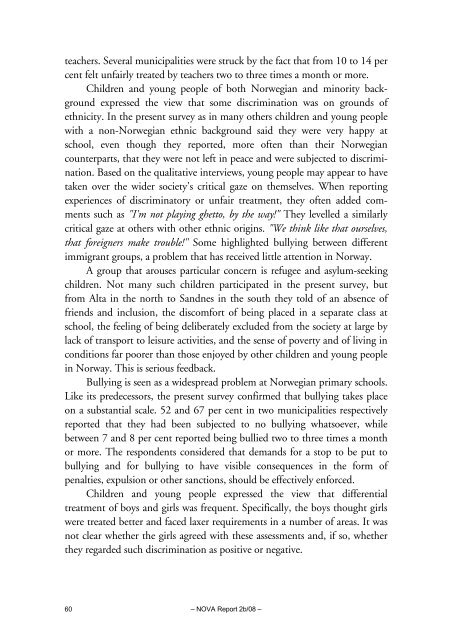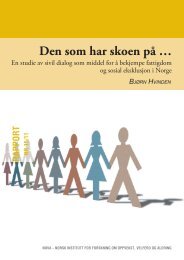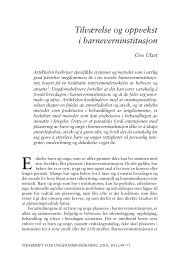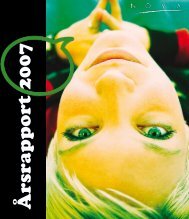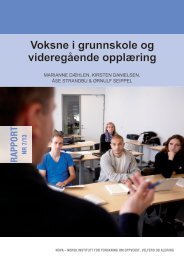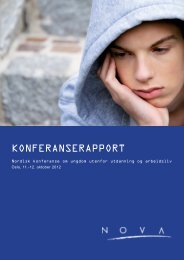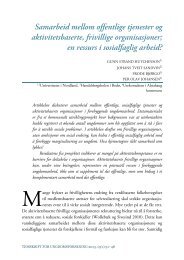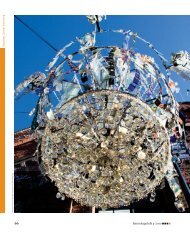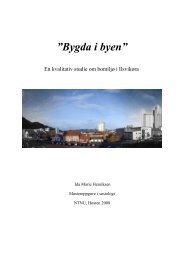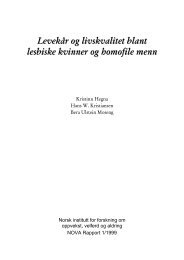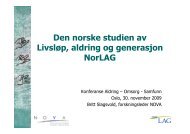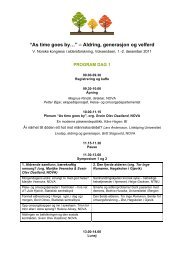children and young people report to the UN on their rights - Nova
children and young people report to the UN on their rights - Nova
children and young people report to the UN on their rights - Nova
You also want an ePaper? Increase the reach of your titles
YUMPU automatically turns print PDFs into web optimized ePapers that Google loves.
teachers. Several municipalities were struck by <str<strong>on</strong>g>the</str<strong>on</strong>g> fact that from 10 <str<strong>on</strong>g>to</str<strong>on</strong>g> 14 percent felt unfairly treated by teachers two <str<strong>on</strong>g>to</str<strong>on</strong>g> three times a m<strong>on</strong>th or more.Children <str<strong>on</strong>g>and</str<strong>on</strong>g> <str<strong>on</strong>g>young</str<strong>on</strong>g> <str<strong>on</strong>g>people</str<strong>on</strong>g> of both Norwegian <str<strong>on</strong>g>and</str<strong>on</strong>g> minority backgroundexpressed <str<strong>on</strong>g>the</str<strong>on</strong>g> view that some discriminati<strong>on</strong> was <strong>on</strong> grounds ofethnicity. In <str<strong>on</strong>g>the</str<strong>on</strong>g> present survey as in many o<str<strong>on</strong>g>the</str<strong>on</strong>g>rs <str<strong>on</strong>g>children</str<strong>on</strong>g> <str<strong>on</strong>g>and</str<strong>on</strong>g> <str<strong>on</strong>g>young</str<strong>on</strong>g> <str<strong>on</strong>g>people</str<strong>on</strong>g>with a n<strong>on</strong>-Norwegian ethnic background said <str<strong>on</strong>g>the</str<strong>on</strong>g>y were very happy atschool, even though <str<strong>on</strong>g>the</str<strong>on</strong>g>y <str<strong>on</strong>g>report</str<strong>on</strong>g>ed, more often than <str<strong>on</strong>g>the</str<strong>on</strong>g>ir Norwegiancounterparts, that <str<strong>on</strong>g>the</str<strong>on</strong>g>y were not left in peace <str<strong>on</strong>g>and</str<strong>on</strong>g> were subjected <str<strong>on</strong>g>to</str<strong>on</strong>g> discriminati<strong>on</strong>.Based <strong>on</strong> <str<strong>on</strong>g>the</str<strong>on</strong>g> qualitative interviews, <str<strong>on</strong>g>young</str<strong>on</strong>g> <str<strong>on</strong>g>people</str<strong>on</strong>g> may appear <str<strong>on</strong>g>to</str<strong>on</strong>g> havetaken over <str<strong>on</strong>g>the</str<strong>on</strong>g> wider society's critical gaze <strong>on</strong> <str<strong>on</strong>g>the</str<strong>on</strong>g>mselves. When <str<strong>on</strong>g>report</str<strong>on</strong>g>ingexperiences of discrimina<str<strong>on</strong>g>to</str<strong>on</strong>g>ry or unfair treatment, <str<strong>on</strong>g>the</str<strong>on</strong>g>y often added commentssuch as "I'm not playing ghet<str<strong>on</strong>g>to</str<strong>on</strong>g>, by <str<strong>on</strong>g>the</str<strong>on</strong>g> way!" They levelled a similarlycritical gaze at o<str<strong>on</strong>g>the</str<strong>on</strong>g>rs with o<str<strong>on</strong>g>the</str<strong>on</strong>g>r ethnic origins. "We think like that ourselves,that foreigners make trouble!" Some highlighted bullying between differentimmigrant groups, a problem that has received little attenti<strong>on</strong> in Norway.A group that arouses particular c<strong>on</strong>cern is refugee <str<strong>on</strong>g>and</str<strong>on</strong>g> asylum-seeking<str<strong>on</strong>g>children</str<strong>on</strong>g>. Not many such <str<strong>on</strong>g>children</str<strong>on</strong>g> participated in <str<strong>on</strong>g>the</str<strong>on</strong>g> present survey, butfrom Alta in <str<strong>on</strong>g>the</str<strong>on</strong>g> north <str<strong>on</strong>g>to</str<strong>on</strong>g> S<str<strong>on</strong>g>and</str<strong>on</strong>g>nes in <str<strong>on</strong>g>the</str<strong>on</strong>g> south <str<strong>on</strong>g>the</str<strong>on</strong>g>y <str<strong>on</strong>g>to</str<strong>on</strong>g>ld of an absence offriends <str<strong>on</strong>g>and</str<strong>on</strong>g> inclusi<strong>on</strong>, <str<strong>on</strong>g>the</str<strong>on</strong>g> discomfort of being placed in a separate class atschool, <str<strong>on</strong>g>the</str<strong>on</strong>g> feeling of being deliberately excluded from <str<strong>on</strong>g>the</str<strong>on</strong>g> society at large bylack of transport <str<strong>on</strong>g>to</str<strong>on</strong>g> leisure activities, <str<strong>on</strong>g>and</str<strong>on</strong>g> <str<strong>on</strong>g>the</str<strong>on</strong>g> sense of poverty <str<strong>on</strong>g>and</str<strong>on</strong>g> of living inc<strong>on</strong>diti<strong>on</strong>s far poorer than those enjoyed by o<str<strong>on</strong>g>the</str<strong>on</strong>g>r <str<strong>on</strong>g>children</str<strong>on</strong>g> <str<strong>on</strong>g>and</str<strong>on</strong>g> <str<strong>on</strong>g>young</str<strong>on</strong>g> <str<strong>on</strong>g>people</str<strong>on</strong>g>in Norway. This is serious feedback.Bullying is seen as a widespread problem at Norwegian primary schools.Like its predecessors, <str<strong>on</strong>g>the</str<strong>on</strong>g> present survey c<strong>on</strong>firmed that bullying takes place<strong>on</strong> a substantial scale. 52 <str<strong>on</strong>g>and</str<strong>on</strong>g> 67 per cent in two municipalities respectively<str<strong>on</strong>g>report</str<strong>on</strong>g>ed that <str<strong>on</strong>g>the</str<strong>on</strong>g>y had been subjected <str<strong>on</strong>g>to</str<strong>on</strong>g> no bullying whatsoever, whilebetween 7 <str<strong>on</strong>g>and</str<strong>on</strong>g> 8 per cent <str<strong>on</strong>g>report</str<strong>on</strong>g>ed being bullied two <str<strong>on</strong>g>to</str<strong>on</strong>g> three times a m<strong>on</strong>thor more. The resp<strong>on</strong>dents c<strong>on</strong>sidered that dem<str<strong>on</strong>g>and</str<strong>on</strong>g>s for a s<str<strong>on</strong>g>to</str<strong>on</strong>g>p <str<strong>on</strong>g>to</str<strong>on</strong>g> be put <str<strong>on</strong>g>to</str<strong>on</strong>g>bullying <str<strong>on</strong>g>and</str<strong>on</strong>g> for bullying <str<strong>on</strong>g>to</str<strong>on</strong>g> have visible c<strong>on</strong>sequences in <str<strong>on</strong>g>the</str<strong>on</strong>g> form ofpenalties, expulsi<strong>on</strong> or o<str<strong>on</strong>g>the</str<strong>on</strong>g>r sancti<strong>on</strong>s, should be effectively enforced.Children <str<strong>on</strong>g>and</str<strong>on</strong>g> <str<strong>on</strong>g>young</str<strong>on</strong>g> <str<strong>on</strong>g>people</str<strong>on</strong>g> expressed <str<strong>on</strong>g>the</str<strong>on</strong>g> view that differentialtreatment of boys <str<strong>on</strong>g>and</str<strong>on</strong>g> girls was frequent. Specifically, <str<strong>on</strong>g>the</str<strong>on</strong>g> boys thought girlswere treated better <str<strong>on</strong>g>and</str<strong>on</strong>g> faced laxer requirements in a number of areas. It wasnot clear whe<str<strong>on</strong>g>the</str<strong>on</strong>g>r <str<strong>on</strong>g>the</str<strong>on</strong>g> girls agreed with <str<strong>on</strong>g>the</str<strong>on</strong>g>se assessments <str<strong>on</strong>g>and</str<strong>on</strong>g>, if so, whe<str<strong>on</strong>g>the</str<strong>on</strong>g>r<str<strong>on</strong>g>the</str<strong>on</strong>g>y regarded such discriminati<strong>on</strong> as positive or negative.60– NOVA Report 2b/08 –


